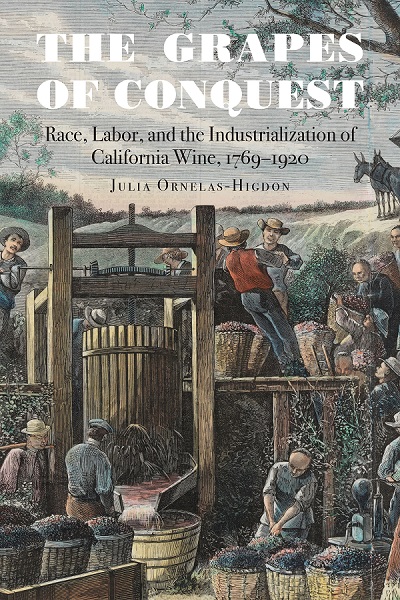 Nov. 13, 2023 - Each year the holidays mark the biggest season for wine sales, with Christmas and New Year’s Eve topping $1 billion in the U.S. during the final two weeks of December.
Nov. 13, 2023 - Each year the holidays mark the biggest season for wine sales, with Christmas and New Year’s Eve topping $1 billion in the U.S. during the final two weeks of December.
When we think of California wine, we usually think of fine dining, romance, elegant parties and other underpinnings of wealth, said CSU Channel Islands (CSUCI) Associate Professor of History Julia Ornelas-Higdon.
“It’s not just a drink, it’s a lifestyle,” Ornelas-Higdon said. “It has a very polished veneer. We associate it with elite populations. It’s a refined drink. No one talks about throwing back cabernet sauvignon at a tailgate party.”
The truth is the people upon whose backs the wine industry was forged are largely lost to California wine history.
“When you peel back the historical layers, it was a diverse, working-class venture from its inception,” Ornelas-Higdon said. “It was an industry build by immigrant populations of color—one where migrants from the eastern United States, Germany, Mexico, China and Indigenous Californians came together in the vineyard.”
Ornelas-Higdon unearths the wine industry’s multicultural roots in her new book “The Grapes of Conquest: Race, Labor, and the Industrialization of California Wine, 1769-1920” published by the University of Nebraska Press.
The book documents the genesis of California viticulture in the 18th century, when Spanish missionaries such as Junipero Serra established missions across the state with the intent of colonizing and converting Indigenous people to Catholicism.
“When the Franciscans arrived, they needed wine in order to do the eucharist, which was crucial to converting the native people,” Ornelas-Higdon said. “They were bringing wine up from Mexico but the supply ships were irregular.”
Ornelas-Higdon read one letter written by Father Junipero Serra in which he expressed relief that kegs of wine had arrived via supply ships, giving him “the satisfaction of being able to say mass.”
 In order to have a local wine supply, the Franciscans forced the Chumash and other California Natives to work planting and harvesting vineyards. They brought migrant workers—natives from the missions in Baja—to teach the local indigenous people how to tend to the grapes and make the wine. Vineyard work was backbreaking labor.
In order to have a local wine supply, the Franciscans forced the Chumash and other California Natives to work planting and harvesting vineyards. They brought migrant workers—natives from the missions in Baja—to teach the local indigenous people how to tend to the grapes and make the wine. Vineyard work was backbreaking labor.
“The work involved using a short-handed shovel which made for backbreaking stoop labor,” Ornelas-Higdon said. “There was no mechanized grape crusher so the California natives crushed the grapes with their feet. The wine would be transferred to leather bags to ferment as oak was scarce.”
Later in the 19th century, the wine was kept in underground tunnels. As the wine industry progressed, vintners sought out Chinese laborers who had been working on building the first railroad.
“The Chinese had so much experience with the railroads, they knew how to use dynamite and how to build structurally sound tunnels,” Ornelas-Higdon said.
Ornelas grew up in Fairfield, California where she saw apricot, pear and walnut orchards torn out and replaced with vineyards. Her grandfathers were braceros, temporary migrant workers, so when it came time to consider a subject for her doctoral thesis, she wanted to research something about agriculture and labor in the 20th century. The idea to write the book happened as so many great ideas happen - over a glass of wine.
“I stumbled onto the idea of wine during a serendipitous and somewhat tipsy conversation at my parents’ table,” Ornelas-Higdon said. “I was stressing about not having a topic for my seminar and my mom said, what about the wine cellars?”
She was referring to the history of the wine storage tunnels built largely by Chinese laborers, but Ornelas-Higdon’s fellow historians urged her to look back even further, to the Mission era, and she was hooked.
The rich diversity of California’s historic wine industry continues today. Napa and Sonoma counties are home to thriving Mexican American communities as well as Mexican guest workers. Their labor drives the California wine industry, which today is an important mainstay of the state’s economy. The Mexican American Vintners Association (MAVA), a professional trade organization, also celebrates the often-overlooked contributions of Mexican-Americans in the wine industry.
Ornelas-Higdon hopes her book helps raise the profile of the workers who toiled in the vineyards through the centuries, hewing out the foundation for the $40 billion-dollar California wine industry.
For more on “The Grapes of Conquest” visit The University of Nebraska Press.
